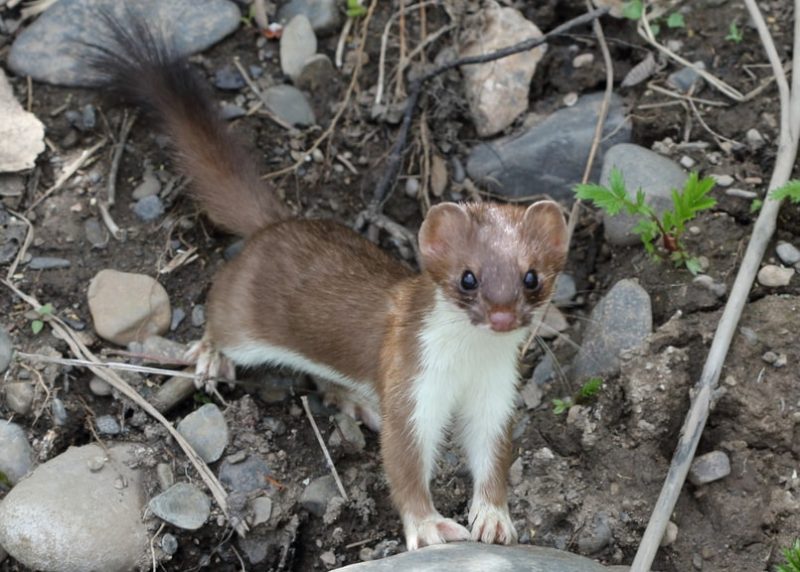Vermont’s diverse landscapes, including forests, meadows, and wetlands, provide the perfect habitat for two fascinating species of weasels. These small, quick-moving mammals are among the most skillful hunters in the state’s natural ecosystem.
Although tiny in size, weasels are fearless predators that play an important role in keeping rodent populations under control. Their agility and sharp instincts make them highly effective at tracking and capturing prey, even in narrow tunnels and hidden spaces.
Despite their cute and curious appearance, weasels are incredibly well adapted to Vermont’s cold winters. Both species change their coats with the seasons, turning white in winter to blend into the snow and remain hidden from both prey and predators.
Common Types of Weasels Found in Vermont
Long-Tailed Weasel (Neogale frenata)

The Long-Tailed Weasel is the most common and widely distributed weasel species found across Vermont. This sleek and slender predator is easily recognized by its elongated body, short legs, and distinctive tail that makes up nearly one-third of its total length. During the warmer months, its fur is a rich brown on the back with a contrasting creamy white underside. As winter arrives, northern populations undergo a dramatic transformation, turning completely white except for the tip of the tail, which stays black throughout the year. Adult Long-Tailed Weasels typically measure between 11 and 22 inches from nose to tail, with males being noticeably larger than females.
Highly energetic and incredibly agile, the Long-Tailed Weasel is built for hunting. It relies on its speed, flexibility, and sharp teeth to pursue prey through tunnels, burrows, and tight crevices where few other predators can follow. Its diet consists mainly of small mammals such as mice, voles, and rabbits, but it also takes birds, insects, and amphibians when available. Despite its small stature, this species is capable of overpowering animals much larger than itself by delivering a precise, fatal bite to the neck.
Long-Tailed Weasels are opportunistic hunters that rarely remain still for long. They are mostly nocturnal, but they may also hunt during early morning or late afternoon, especially during cooler months when prey is more active. Unlike many predators that rely on scent marking, the Long-Tailed Weasel depends heavily on sight and sound to detect movement. They are also known for their playful and curious nature, often standing upright on their hind legs to survey their surroundings before darting back into cover.
In Vermont, Long-Tailed Weasels thrive in a wide variety of habitats, including forest edges, open meadows, brushy fields, and wetlands. They prefer areas with abundant cover and easy access to prey, often building their dens under rocks, tree roots, or inside hollow logs. Some take over abandoned burrows of rodents or rabbits, lining them with grass and fur for insulation. Because of their adaptability, they can be found in both rural and suburban areas, sometimes near barns or old stone walls where rodents are plentiful.
This species plays a crucial ecological role in maintaining balance within Vermont’s natural communities. By controlling populations of mice and other small mammals, the Long-Tailed Weasel helps protect crops, reduce disease risk, and preserve the health of native habitats. Although secretive and seldom seen, its presence is a sign of a thriving and balanced ecosystem across the Green Mountain State.
Short-Tailed Weasel (Mustela erminea)

The Short-Tailed Weasel, more commonly known as the Ermine or Stoat, is another native species found throughout Vermont. This small but fierce predator is one of the most iconic mammals of northern North America. Compared to its close relative, the Long-Tailed Weasel, the Short-Tailed Weasel is smaller, measuring about 7 to 13 inches in total length, with a shorter, rounded tail that ends in a distinct black tip. During the summer months, it wears a sleek brown coat on top with a clean white belly, but as winter approaches, its fur transforms into a pristine white, allowing it to blend seamlessly into snowy landscapes. Historically, this luxurious white winter coat made the Ermine’s fur one of the most sought-after in the fur trade.
The Ermine is known for its boundless energy, quick reflexes, and bold hunting style. It is a skilled carnivore that preys primarily on voles, shrews, mice, and small birds, though it will also consume insects and amphibians when available. What makes this species particularly interesting is its habit of storing excess food in its den for later use — a smart adaptation to survive Vermont’s harsh winters when prey may be scarce. Observers often note its curious behavior, as Ermines frequently stand upright on their hind legs to get a better view of their surroundings before darting swiftly into cover.
Despite its small size, the Short-Tailed Weasel is incredibly courageous and can defend itself fiercely against larger animals. It hunts with remarkable precision, delivering a quick bite to the back of the neck to subdue prey instantly. The Ermine’s hunting success depends on its agility, slender body, and ability to enter the burrows of its prey. This efficient predator plays an essential role in keeping rodent populations balanced, helping to protect crops and natural vegetation from overgrazing.
The preferred habitats of the Short-Tailed Weasel in Vermont include woodlands, open fields, and farmlands, particularly areas that provide dense vegetation, stone walls, or brush piles for cover. They often create dens in hollow logs, under tree roots, or inside abandoned burrows left by rodents or rabbits. The species is especially abundant in northern and mountainous parts of Vermont, where long, snowy winters favor its seasonal white coat.
Adaptability is one of the Ermine’s greatest strengths. Whether living in forests, rural landscapes, or near human settlements, it can thrive wherever small prey is plentiful and safe hiding spots are available. As an important predator in Vermont’s ecosystems, the Short-Tailed Weasel maintains a delicate ecological balance, supporting healthy populations of both prey and vegetation across the state’s natural habitats.
Behavior and Adaptations of Weasels in Vermont
Weasels in Vermont display a fascinating blend of intelligence, agility, and instinct, making them some of the most capable small predators in the region. Their behavior is shaped by both their physical adaptations and the seasonal changes of New England’s environment. As active hunters, they rely on stealth, speed, and alert senses to survive in habitats ranging from dense forests to open fields. Their elongated, flexible bodies allow them to move effortlessly through tunnels, rock crevices, and underbrush, accessing areas that larger predators cannot reach.
Weasels are known for their high energy and relentless hunting habits. They have extremely fast metabolisms and must eat frequently to maintain their body temperature and energy levels. It’s not uncommon for a weasel to consume food equal to its own body weight in a single day. This constant need for nourishment drives their bold, tireless behavior — they are almost always on the move, searching for their next meal. Their diet mainly consists of rodents, but they are also opportunistic and will hunt birds, frogs, and insects when available.
Seasonal changes play a major role in weasel adaptations. During the winter months, both Vermont species — the Long-Tailed Weasel and the Short-Tailed Weasel (Ermine) — undergo a remarkable transformation in coat color. Their fur shifts from brown to pure white, with only the tip of the tail remaining black. This seasonal camouflage helps them blend into snowy surroundings, keeping them safe from predators such as owls, foxes, and coyotes while allowing them to approach prey undetected.
Weasels also exhibit interesting behavioral traits related to survival and hunting. They often perform what’s known as a “weasel dance” — a playful, erratic series of jumps and twists used to confuse or distract prey before attacking. They may store extra food in their dens during periods of abundance, ensuring they have sustenance during leaner times. Though solitary by nature, they are highly territorial and use scent markings to establish boundaries, particularly during breeding season.
In every aspect, from their quick movements to their sharp instincts, weasels are master survivors. Their adaptability to Vermont’s cold winters and varied terrain demonstrates how evolution has finely tuned them for success in challenging environments.
Weasels and Vermont’s Ecosystem
Weasels play a vital ecological role within Vermont’s diverse natural landscapes. As mid-sized predators, they help maintain the delicate balance between prey and plant life. Their primary diet — consisting of rodents like mice, voles, and shrews — prevents these populations from growing out of control. Without predators such as weasels, small mammals could quickly overpopulate, leading to damage in forests, farmlands, and gardens due to overgrazing and burrowing. By naturally managing these prey species, weasels act as a form of biological pest control, benefiting both agriculture and the broader ecosystem.
Their influence extends beyond simple population control. By preying on rodents that consume seeds and seedlings, weasels indirectly support forest regeneration and plant diversity. This allows Vermont’s woodlands and meadows to remain healthy and self-sustaining. Their hunting activity also benefits larger predators, such as hawks and foxes, which often feed on the same prey and rely on balanced populations for survival.
The presence of weasels in an area is often seen as a positive indicator of environmental health. They require clean water, sufficient prey, and stable vegetation cover — all signs of a thriving ecosystem. When weasels disappear from a region, it may suggest habitat degradation, pesticide overuse, or disruptions in food availability. Because of this, biologists often consider them a valuable “indicator species” for monitoring ecosystem stability.
In addition to their ecological importance, weasels hold cultural and scientific value. Their ability to adapt, hunt efficiently, and survive in harsh Vermont winters continues to inspire wildlife researchers and nature enthusiasts. Observing a weasel in the wild — even for a brief moment — is a reminder of how every small predator contributes to the balance and resilience of Vermont’s natural world.
Tips for Spotting Weasels in Vermont
Weasels are secretive and quick, making them a rare sight in the wild, even though they are widespread throughout Vermont. To improve your chances of seeing one, explore quiet natural areas during the early morning or late evening hours when these predators are most active. Forest edges, grassy meadows, and areas near streams or old stone walls often serve as prime hunting grounds for both the Long-Tailed and Short-Tailed Weasel.
One of the most reliable ways to detect their presence is by looking for tracks or subtle signs of activity rather than the animals themselves. In winter, you might spot tiny footprints in fresh snow with a bounding pattern — pairs of prints close together, showing where the weasel landed after a quick leap. You can also look for small tunnels or runways through tall grass or beneath brush, which are often used as hunting paths or escape routes.
If you come across a small carcass with clean, precise bite marks at the neck, it may be evidence of a weasel kill. Their hunting method is swift and efficient, targeting the base of the skull to immobilize prey instantly. These signs, along with small dens hidden in stone walls, woodpiles, or hollow logs, often reveal that a weasel is nearby even if you never see it directly.
Patience and silence are essential when observing wildlife as elusive as weasels. Stand still and listen carefully — sometimes a rustle in the leaves, a flash of white fur in winter, or quick movement near a rock pile is all the clue you’ll get. Watching for them during cold months, when snow offers a bright backdrop, can make spotting easier. With quiet persistence and a bit of luck, you may be rewarded with a brief but unforgettable glimpse of these agile hunters in their natural Vermont habitat.
FAQs about Weasels in Vermont
What do weasels eat in Vermont?
Weasels primarily eat small mammals like mice, voles, and shrews, but they also hunt birds, insects, and frogs. They are carnivores and play an important role in controlling rodent populations.
Do weasels in Vermont turn white in winter?
Yes, both the Long-Tailed and Short-Tailed Weasel change their fur to white during the winter months. This adaptation helps them blend in with snow and avoid predators.
Are weasels dangerous to humans or pets?
Weasels are not dangerous to humans and typically avoid confrontation. However, they can occasionally prey on small poultry or pet birds if given access.
Where can I find weasels in Vermont?
Weasels can be found throughout Vermont in forests, meadows, and near wetlands. They prefer habitats with plenty of cover and an abundant supply of small rodents.






